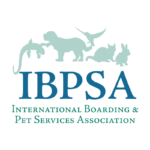Pet boarders make it possible for humans to leave their animal friends in good care while they travel. Many vacation destinations do not allow pets, while navigating airports and airplanes is often impractical with an animal.

That’s where pet boarders provide a valuable service. The key difference between pet boarding and similar services, such as pet sitting, is the animal is cared for in a secure facility away from home. While some people may prefer a pet sitter who comes to the home their pets are accustomed to and where they might be more comfortable in familiar surroundings, pet sitting is not always an option or even the best choice.
If a working professional gets marching orders from the boss to take a business trip on short notice, a pet sitter may not be available, whereas you can almost always check pets into a boarding facility. Other factors where boarding is the better choice include weather conditions. If someone is traveling in winter and a major snowstorm hits, the pet sitter may not be able to reach the house where the pet is staying. Worse, a power outage caused by a storm would leave animals without heat in the house. For these and other reasons, pet boarding remains a great business with consistent demand.
Pet boarders keep regular schedules to satisfy the instructions of the pet owner. Animals get regular exercise, play time, treats and affection. Their training includes first aid and emergency care, which provide pet owners with peace of mind while they are away.
Pet boarders also make a good income while working with animals to make them as comfortable and happy as possible while their human “parents” are elsewhere. It’s a satisfying and financially rewarding career for people who enjoy working with animals. If that sounds appealing, read on to discover what’s involved in becoming a pet boarder.
In this article you’ll learn:
- How much money you can make as a pet boarder
- The required training and certifications
- Professional groups to join
- Employment opportunities for pet boarders
- Finding clients
- Plus helpful tips
How much money can you make?
Pet boarders typically set their rates based by the day, night, week and month. The national average is $25 a day, $40 for overnight, about $150 for a week or $500 a month. Fees may or may not include food, treats and play toys. Additional services such as training and dog walking are usually provided at additional cost. Some pets have special dietary requirements or are accustomed to a particular brand of food, in which case their owners should be expected to provide a supply of food for the duration of the pet’s boarding. It is also the owner’s responsibility to bring any medicines prescribed for the pet.

Individuals who run their own boarding business and care for multiple pets at a time will make the most money in this career. Those who board pets in their own homes can make a good income as a said business.
Training and Certification
Anyone can set up a business as a pet boarder. There are no specific licensing requirements beyond purchasing a basic business license, which all states require to sell services and products to the public. You may also need a local permit to provide animal care, but that’s it.
Still, training and certification promotes confidence, both in yourself and your customers. An accredited pet boarding service has a competitive advantage over boarders that are not accredited. Think about it. Given the option, which one would you entrust to care for your pet?

You can start with an animal care certificate from the local community college or work with a veterinary office or a pet boarding facility. Formal training is available online and through in-person programs, with costs as low as $130.
Here’s a directory of training programs for pet boarding you can review as you evaluate your options.
Some of what you can expect to learn in training:
- Setting up an overnight boarding business
- Caring for pets
- Working with different animals and breeds
- First aid for animals in distress
- Basic training for dogs
- Managing catteries
- Grooming skills
- Hiring and supervising staff
- Communicating effectively with pet owners
- Basic business skills
If you plan to open your own boarding facility, consider applying for an endorsement from the Professional Animal Care Certification Council. The council’s mission “is to bring independent testing and certification to the pet care services industry.” Professionals that pass stringent testing, which reflects a broad knowledge of animal care, receive a 3-year certification. There are three levels of PACCC certification: Certified Professional Animal Care Provider, Manager and Operator. Once you’re in, your business will also be listed on the council’s online directory of certified pet boarders and you’ll be able to use this designation on marketing materials.
Here’s a list of more than a dozen pet boarder training programs and schools to help you get started.

Professional Groups to Join
Membership in professional organizations shows you are serious about your career. Customers and potential employers look favorably on these affiliations. The benefits to you include networking with other pros in your field, learning about job opportunities, gaining access to continuing education materials and, with some organizations, the opportunity to purchase affordable liability insurance at group rates.
The International Boarding and Pet Services Association offers information on business assets, industry mastery, staff education and training, accreditations, and authoritative help for the pet services industry. Members include the owners and employees of pet boarding offices, dog walkers, pet sitters, veterinarians, trainers and pet suppliers. Benefits include training and certification programs, a listing on their searchable online directory of pet boarders, industry news, workshops and an annual conference. A membership costs $302 per year.

The Association of Animal Behavior Professionals (AABP) was founded as a professional association and certifying body supporting a community of animal behavior technologists utilizing non-coercive methods in working with clients’ companion animals. Benefits include:
- License to market your membership, (including use of the AABP logo)
- Access to a member’s forum for networking and discussion
- Listing on the web site directory
- Members may apply for AABP Certification
- Certification: Emphasized listing on the web site
- Certification: Official “AABP Certified,” which may be used for marketing purposes
- Certification: Use of the “AABP Certified Member” logo
You can also find many informal groups for pet boarders to discuss their profession. This list features dozens of online networking groups for pet boarders that you can review and consider joining.
Employment
You’ll find jobs for pet boarders at large veterinary practices that offer boarding as well as private boarding companies. Make copies of your resume and professional credentials in advance so you’ll have them ready.
Also check online job-search services like Indeed and ZipRecruiter. You can set up notifications on these sites to receive email alerts about openings that match your geographic location.
Finding Clients
Success as a pet boarder means attracting a steady stream of clients. Ideally, you’ll get repeat customers and new customers. This will help you stay busy and sustain that all-important cash flow

First, you’ll need business cards and a website for marketing your boarding services. Your website should include pictures of your facility and staff working with different pets, a list of the services you provide, as well as your location and contact information, which must be clearly visible at the top of every page on your site. The upper right-hand corner is a good spot for your location, phone number and email, but wherever you display this information it must be in the same place on every page. Search engines scan this information to match your website geographically with people searching for pet boarding.
Other ways to grow your business:
Veterinarian Referrals
Contact local veterinarians and cultivate friendly business relationships with them. Dog owners routinely ask their vets about other pet needs, including boarding, so you will want to be the professional that vets recommend to their clients.
Partner with Local Shelters or SPCA
This gets your business in front of people who are adopting pets. Your partnership can be as simple as dropping off advertising flyers and business cards at the local shelter or SPCA. Volunteering for an hour or two each month can build goodwill.
Partner with Independent Pet Stores
Small business owners understand the value of collaborating with other professionals in the community. Focus especially on pet stores that sell organic animal food, specialty chew toys and other pricey items that tend to attract more affluent customers. These are more often people with disposable income who lead busy lives and go on vacations, which means they need to board their pets.
Good to know
Marketing a pet boarding business can consume a huge amount of time if you allow it to happen. Follow the steps above to be proactive in attracting clients, but also set up your online presence. A professional website in tandem with social media pages can be working for you around the clock, driving customers to your door. Consider these strategies for connecting with customers who need pet boarding:

Set up an Instagram page to showcase your pet boarding business. Instagram is the #1 online venue for small business owners to showcase their services. A dedicated business page on Instagram is always promoting your business.
Next, build a Facebook business page. This is an easy way to grow your following by providing tips and helpful information to enhance their life with pets. You can run promotions and create teaser links to your business website by offering articles and news about pets in your Facebook posts.
Now create a Google My Business page. This service lets you list hours of operation, photos of your boarding facility and a map of your location. There’s also an area for people to leave reviews of your services, so you should ask happy customers to post praise on your Google My Business page.
Setting up a business presence on each of these sites should take less than an hour. All of them are free and work 24/7 to promote your pet boarding company. That frees up more of your time to focus on caring for customers’ pets.
If you enjoyed this article, check out some more great PocketSuite.io content that can help you grow your career as a pet boarder. Here’s a great place to start.
PocketSuite has thousands of business owners who all started where you are right now. Our community is always happy to help you ramp up, grow your client base, and achieve your income goals, both within the PocketSuite app and as part of our exclusive Facebook Community Group. PocketSuite’s vision is for any professional to be able to work for themselves and make a great living. It starts here. It starts with you. It starts today. Let’s get started, download PocketSuite now! Feel free to reach out with any questions (we’d love to hear from you)! Text us @ (415) 841-2300.





